 Report Menu
Report Menu
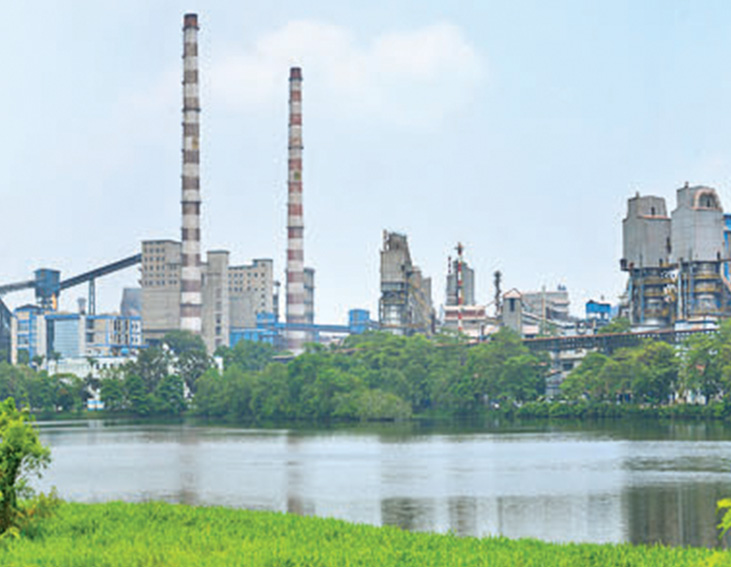
Natural Capital
Conserving natural resources for tomorrow
At Tata Steel, we continuously strive to protect the environment. Our philosophy of minimising environmental impact and promoting resource efficiency guides our investment decisions to monitor and mitigate the impact of our operations. The iron and steel making process involves the use of natural resources such as iron ore, coal, limestone and ferro-alloys and is water and energy intensive. The GHG (particularly CO2) and dust emissions emitted during the process are key contributors to air pollution and global warming. Maintaining sustainable operations and continually making improvements to our products and processes help us minimise our environmental footprint.

We are in constant pursuit of minimising our environmental impacts and conserving the natural environment around us.
STRATEGIC FOCUS
- SO4
To achieve industry leadership in Corporate Social Responsibility and Safety Health & Environment.
WAY FORWARD
We are investing in technologies to achieve the highest environmental performance standards. We plan to achieve this by adopting breakthrough technologies for raw materials management, higher utilisation of LD slag, setting up the steel recycling business, achieving zero water discharge, carrying out lifecycle assessments of our products and embedding the principles of circular economy in our operations.
GOALS
<2 tCO2/tcs GHG emission intensity by 2025
Zero effluent discharge by 2025
Sustain LD slag utilisation at 100%
Ensure no net loss of biodiversity at our mining locations
IMPACT ON SDGs

Managing environmental impact of operations
We have policies and processes in place for reducing energy usage and minimising our environmental footprint across the value chain. We have set stringent targets for energy intensity, greenhouse gas emission, and water conservation. Our efforts also focus on reducing waste, enabling a sustainable supply chain and understanding the impact of our products on the environment through lifecycle assessments.
RAW MATERIALS MANAGEMENT
Our Raw Materials Division not only provides cost-competitiveness to our steel business but also ensures the sustainability of our operations by way of assured supply of requisite quantity and quality of raw materials required for steelmaking. The division is actively engaged in incorporating state-of-the-art technologies while mitigating the possible adverse impact on the environment.
Although, Tata Steel’s current operations in India are not located in any of the identified biodiversity hotspots or protected areas, our mining operations (being extractive in nature) impact the flora and fauna in the region. Therefore, we voluntarily partnered with the International Union for Conservation of Nature (IUCN) at our raw material locations in Jharkhand and Odisha for the implementation of biodiversity management plans.
The mining operations of Tata Steel are working towards enhancing progressive reclamation activities of the mine dumps and ecosystems. In Financial Year 2018-19, the following activities were undertaken in line with our policy objectives of restoring the floral diversity and conservation of keystone species:
- Optimised the plantation programme in terms of precise type and number of native species to be used. The diversity of the native species being used for plantation activities increased by 22% and plantation of primary keystone species increased five times
- Completed the mapping distribution of invasive species at the Joda East iron mine and a systematic eradication and restoration plan is now being implemented
- Planted over 2 lakh saplings of native species across raw material locations
Bird activity was spotted in about 80% nest boxes that were installed last year at Noamundi iron ore mines. This niche nesting programme is being replicated at the Company’s other mining locations.
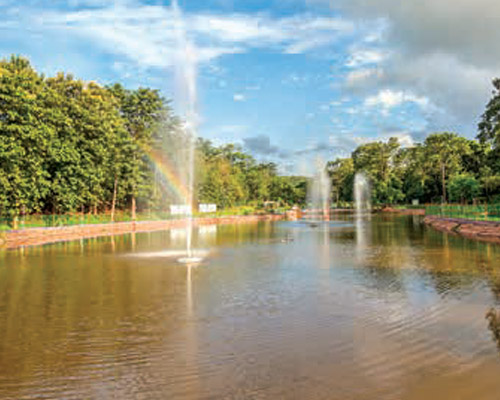
Rain Water Harvesting, Noamundi Iron Mine
Mined raw materials

Imported raw materials


Niche Nesting, Noamundi Mine Area
ENVIRONMENTAL MANAGEMENT
We believe responsible environmental performance is an inherent element of our business strategy and these practices help us achieve a leadership position in the industry. In Financial Year 2018-19, we spent ₹286 crore on environmental management efforts focussed on the four pillars of emission, water management, circular economy and biodiversity.
Four pillars for environmental management
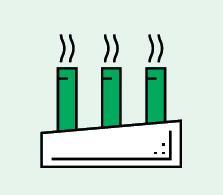
Emissions performance

Water management

Circular economy

Biodiveristy
Emissions performance
CO2 emission
The Paris agreement aims at arresting the global warming to <2 degrees celsius for which the key requirement is to make CO2 emission net zero by 2050. The steel industry contributes to about 6-8% of global emission and is considered to be a ‘hard to abate sector’ since carbon is used as a reductant in the steelmaking process and low carbon steelmaking technologies are yet to be commercialised. Cognisant of India’s commitment and the sectoral requirements, Tata Steel has set an aspirational goal of <2 tCO2/tcs emission by 2025.
Over the years, the adoption of best available technologies for waste heat recovery such as Top Recovery Turbine (TRT), Coke Dry Quenching (CDQ), use of by-product gases in power generation and other energy efficiency initiatives have resulted in improving resource efficiency as well as reducing carbon footprint. We continue to implement Internal Carbon Pricing in our capital expenditure appraisal process with the shadow price of carbon at US$ 15 /tCO2.
A benchmark for the industry
Tata Steel Jamshedpur is the Indian benchmark for CO2 emission intensity at 2.29 tCO2/tcs and energy intensity at 5.67 GCal/tcs for steel production through Blast Furnace - Basic Oxygen Furnace (BF-BOF) route.
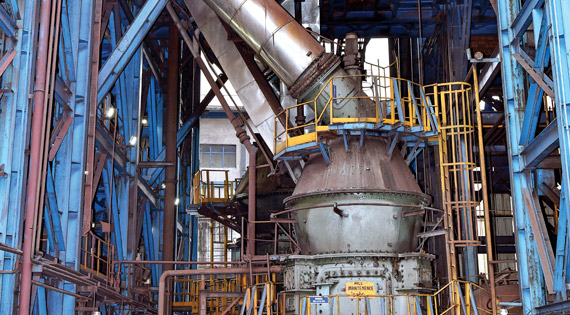
A Centre of Excellence with members from iron making, steelmaking, R&D and technology groups was constituted in Financial Year 2018-19 to identify and implement projects for CO2 reduction. Some such projects are:
- Carbon Capture and Use (CCU) at Tata Steel Jamshedpur and at the Ferro-Chrome plant at Bamnipal
- Assessing renewable energy potential across our locations in India
- Maximising scrap utilisation in steelmaking
GHG emission from our steelmaking operations (Absolute emission in million tCO2)
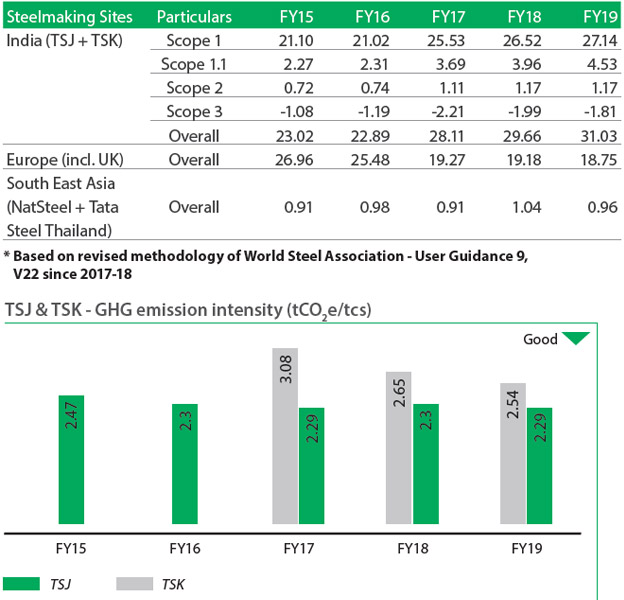
Product Lifecycle assessment
Tata Steel uses Life Cycle Assessment (LCA) as a tool to assess environmental impacts at the various stages of its products’ lifecycle. Moving forward, LCA would be used to undertake Environmental Product Declaration (EPD) for key products of Tata Steel. In Financial Year 2018-19, Tata Pravesh Doors, Tata Structura and Tata Pipes achieved the GreenPro certification by CII Green Business Centre – these are the first steel products in India to get the eco-label using the LCA study.
In recognising the tangible business benefits of disclosure through Carbon Disclosure Project (CDP), Tata Steel is well placed to take meaningful steps to address its environmental impacts. This can help to ensure the Company’s long-term sustainability and profitability, as well as equipping it to respond to regulatory and policy changes, such as the Paris Agreement.
Damandeep Singh
Director, CDP India
Minimising dust and gaseous emissions
Over the last two decades, Tata Steel has made investments in installation and upgradation of air pollution control equipment at both its manufacturing sites. Over the last five years, a total of 24 projects have been implemented to upgrade the existing air pollution control equipment, including upgradation of all Electrostatic Precipitators (ESPs) at the sinter plant. An online stack monitoring system has been commissioned in all major stacks. Dust emission (PM2.5 and PM10) is also a key material issue especially at TSJ, since the steel plant is located in the midst of the city. These efforts have resulted in 68% reduction in dust emission at TSJ since 2005. While production at TSJ has more than doubled since 2005, absolute dust emission has reduced by approximately 35%. Pollution control facilities were fully commissioned during the ramp-up at our Kalinganagar facility, resulting in a reduction of almost 9% dust emission over the past year.
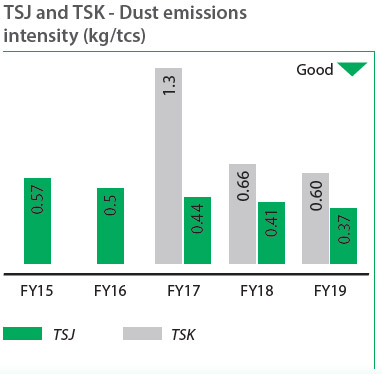
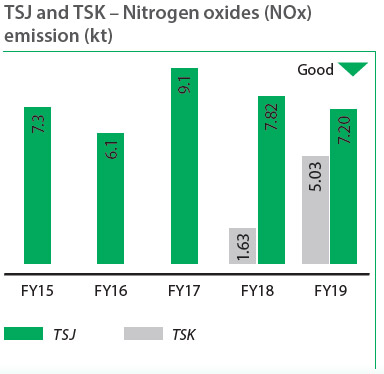
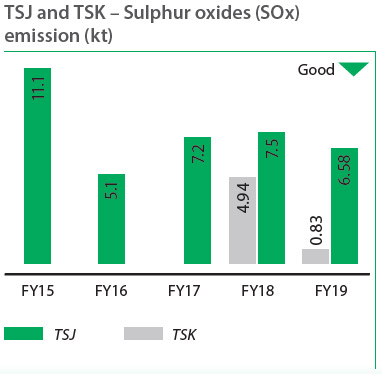
Water management
Water is a critical resource used as a coolant in the steelmaking process. Currently over 3m3 of freshwater is required per tonne of crude steel produced. Our operations in India are located near the Subarnarekha (TSJ) and Baitarani (TSK) rivers. We also have a water reservoir, Dimna Lake, at Jamshedpur with a holding capacity of 6,292 million gallons of rain water, which can meet nearly 14% of freshwater demand of the township. A river basin study has been initiated for the Subarnarekha river to assess watershed level risks for TSJ and implement better water management plans for improving the water scenario in the district watershed and to ensure optimum water flow in the river throughout the year.
Our water sustainability strategy for future-readiness is to continue investing in Sewage Treatment Plant (STP) and creating new Rain Water Harvesting (RWH) structures at various locations to improve the ground water table. In Financial Year 2018-19, 29 million litres of RWH structures were added at the Joda east iron ore mine. We have also created various rainwater harvesting structures beyond the fence as part of our community initiatives (ponds and check dams) and township infrastructure (rooftop) at Jamshedpur and our mining locations. A 25 MLD tertiary treatment plant was commissioned at Bara STP to convert sewage water of the Jamshedpur township into process water for reuse in Jamshedpur steel works. This will help us reduce our freshwater consumption by 18% in the future.
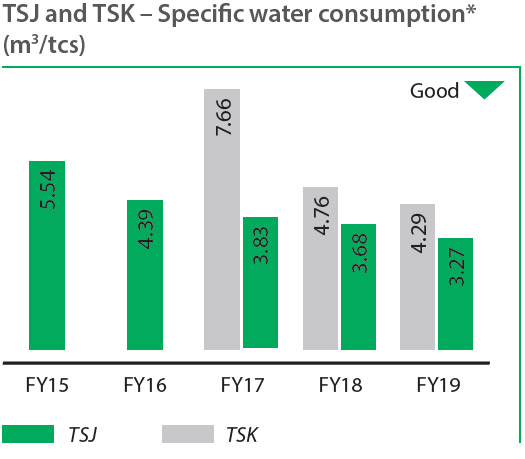
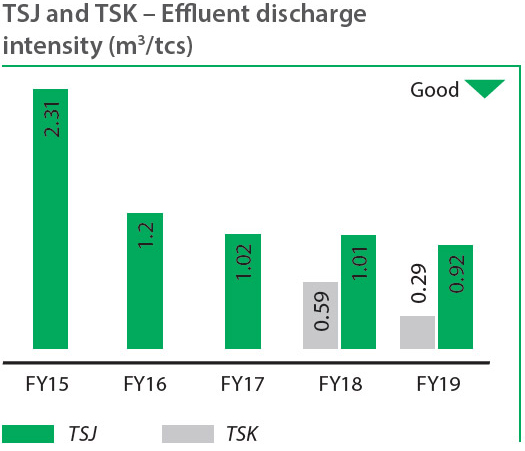
* Specific water consumption is defined as freshwater consumption per tonnne of crude steel produced (at TSK water loss at clarifier is excluded in the calculation)

Tata Steel Bara Tertiary Treatment Plant, Jamshedpur
‘Industrial Water Project of the Year 2019’ Award by the Global Water Intelligence (GWI)
Towards circular economy
Solid waste utilisation
Steel industry is favourably placed for implementing circular economy principles, given the ability to recycle steel as well as use solid waste by-products. The by-products generated across the entire steel value chain include coal rejects from the washeries, coal tar, slag, and scrap from steelmaking shops and rolling mills. Our key initiatives to maximise the utilisation of our by-products are described below:
Recovery and reuse of metal from steelmaking slag:
Recovered metal from steel slag is used in the steelmaking process. This scrap is used in steel melting shops along with clean scrap and pooled iron.
Blast furnace slag and steelmaking (LD) slag utilisation:
Annually, Tata Steel handles ~17 MnTPA of by-products, which are converted and sold across 20+ product categories. The key solid waste generated during an integrated steel plant operation are the blast furnace and LD slag, which, if not utilised would require to be stored in engineered landfills. Granulated blast furnace slag is 100% utilised in Portland slag cement making. However, the LD slag, because of its chemical composition and reactive nature, has limited applications. Tata Steel has developed and launched India’s first ever LD slag branded products – Tata Nirman (for construction application) and Tata Aggreto (for building roads). Road construction is a big market for Tata Aggreto made from processed LD slag. Tata Steel is engaged with government institutions such as Indian Road Congress (IRC) and National Highways Authority of India (NHAI) to promote the use of LD slag as a substitute of natural aggregates in road construction. Sales of Tata Nirman and Tata Aggreto launched last year increased significantly from 230 kt in the previous year to 370 kt this year. Tata Nirman was adjudged as the winner under Green Building Material for AAC Blocks/Bricks & Others at the 8th edition of the National Fly Ash Utilisation Conference held in Goa.
We have achieved nearly 100% slag utilisation across our operations by investing in the processing of by-products and developing alternative use in the construction industry. Facilities for de‑phosphorisation, slag granulation and briquetting are under development, which would further ensure sustained utilisation with higher value addition through usage in sinter making, construction, road making, agriculture, etc.
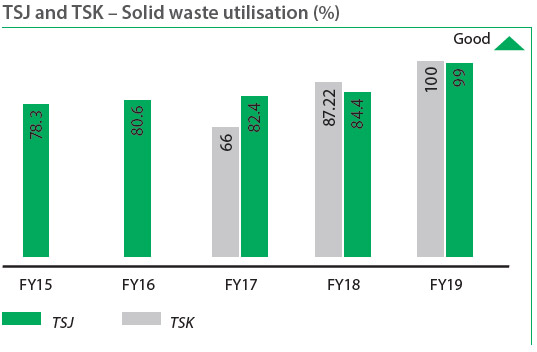
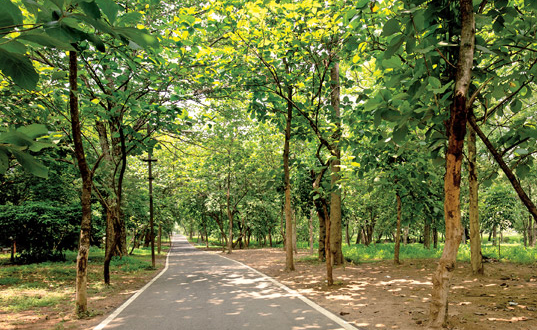
Tata Aggreto used as a Replacement of Natural
Aggregates in Road Construction
Steel recycling business
Steel is 100% recyclable and can be recycled infinitely to create new steel products, making it suitable for a circular economy. Recycled steel maintains the inherent properties of original steel. Steel scrap demand in India at present is 30 MnTPA, with 5 MnTPA being imported. The demand and supply is likely to increase as a result of government policies, rapid urbanisation and economic activity. However, the Indian scrap industry is highly fragmented and unorganised with a complex supply chain, where availability of clean scrap is a challenge. There are many small aggregators who collect scrap from various sources and sell unprocessed scrap with inconsistent quality. There is also a lack of requisite policy framework for this industry in India. Most operations are manual and there is little concern towards safety and environmental issues.
Tata Steel is taking the lead in setting up a steel recycling business with the objective of collecting, aggregating and processing scrap in a formalised way, which can subsequently be used for steelmaking through the Electric Arc Furnace (EAF) route. Steel production through the EAF route uses scrap as key input and is a more sustainable way of producing steel. This could reduce carbon emission by 50-60% as compared to traditional steel production. Through collaboration with the government, Tata Steel wants to formalise this industry and enhance scrap utilisation through partnerships across the supply chain, such as with aggregators, processors, dismantlers, logistics partners and end consumers.
Looking beyond its own operations, Tata Steel is actively working on policy advocacy with various government and industry bodies to build scrap utilisation networks. The resource efficiency policy has been released and the steel scrap policy is in the draft stage. The Bureau of Indian Standards has also constituted a technical committee to review the Scrap Codes.
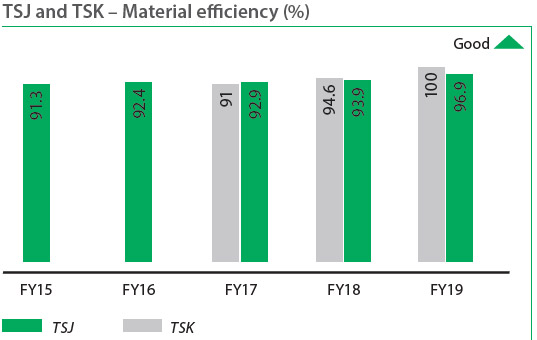
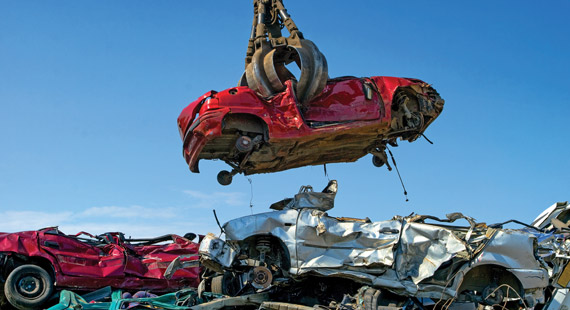
Steel Scrap
A step towards formalising the steel recycling industry
The first steel scrap processing unit is being set up at Rohtak, Haryana, for which Tata Steel has entered into a long-term build-own-operate agreement with Aarti Green Tech Limited. With an investment of ₹150 crore, the first unit will have an installed capacity of 0.5 MnTPA. Digital platforms and channel networks will help collect scrap from various segments such as households, industries and end-of-life vehicles. This scrap will be processed through mechanised equipment and used as an input raw material for downstream steelmaking through EAF. Commercial production is expected to begin in Financial Year 2019-20 with plans to subsequently expand across India.
